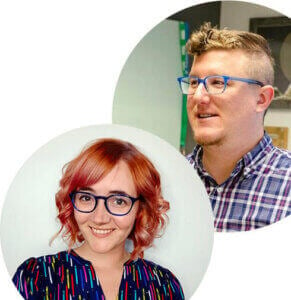A Competitive Landscape Analysis (CLA) makes brand work feel like a foregone conclusion—even though it isn’t.
Branding. For many companies, it’s an emotionally fraught topic. On one end of the spectrum are those for whom every decision is weighted with significance, and the ramifications of making the wrong choice could have disastrous consequences for the company. On the other end are the skeptics, who openly question whether the entire practice does anything at all. Those caught between may have feelings that are no less strong, and no one knows whose position is the most correct.
If this sounds familiar to you, then here are a few words you probably haven’t associated with a branding project:
- Intuitive
- Peaceful
- Comfortable
- Joyful
- Easy
We believe that many of our clients are so used to branding work being difficult, that anything less than emotionally exhausting sounds too good to be true. If art is born of suffering, then brand decisions should be difficult. If it’s not hard, have they done their job?
The result of this mindset is that each idea is massaged and workshopped and debated in committee until everyone is left with a disappointing compromise.
Needless to say, that’s not how it should be.
Competitive research is a key part of brand positioning, learn more in our articles on What is Brand Positioning? and When Do You Need to Focus on Brand Positioning?
CLAs provide an objective groundwork for productive conversation.
Brands are subjective. A brand should evoke specific emotions while also picking at subconscious associations. And this naturally leads many of us to think of the process behind branding work as intangible, something which can only be arrived at through a sudden burst of inspiration.
However, the best brands don’t come out of nowhere. If a brand doesn’t connect with a broad enough audience, it won’t have the desired emotional impact. Enough people have to share a subconscious association with a brand for it to have power. And these ideas and associations aren’t discovered in a board meeting where everyone has their feelings on the table. They’re discovered through research.
Arguing about subjective feelings and opinions introduces a lot of room for doubt, conflict, and second-guessing. CLAs effectively eliminate this issue by laying out the research that informs brand decisions. By providing context and properly framing the brand identity, it becomes easier for stakeholders to come to a consensus that feels natural, satisfying, and bold. When everyone at the table feels confident in the work, branding projects become a turbo boost to company values, rather than a drain.
 Over the years of doing CLAs for our clients, we’ve seen time and again how the research we put into our CLA process pays off by clearing the way for more productive brand discussions and making the thoughtfulness and intent behind our brand work shine. Here’s how our process works, as described by our brand researcher (Laura), and our creative director (Ian).
Over the years of doing CLAs for our clients, we’ve seen time and again how the research we put into our CLA process pays off by clearing the way for more productive brand discussions and making the thoughtfulness and intent behind our brand work shine. Here’s how our process works, as described by our brand researcher (Laura), and our creative director (Ian).
1. Building the competitive and aspirational sets.
Our CLA begins with a review of 20–30 websites, which are divided into “competitive” and “aspirational” sets. We take screenshots of each home page and then arrange them in a matrix that shows how sites from the peer group compare against those in the aspirational group.
Laura: I always start by asking the client for their own list of sites. This lets me know right from the start what they have in mind. The goal isn’t to copy the best sites, of course, but to figure out what ideas are generic or overdone, and what ideas are new and exciting. It’s about finding your desired peer group, and creating a brand that fits in with that peer group.
You know how they say “don’t dress for the job you have, dress for the job you want to have?” Imagine trying to get dressed in the morning without ever having looked at either group. Branding isn’t just about differentiation, it’s also about assimilation. You want to set yourself apart from the peer group, but you also want to show that you belong with the aspirational group.
Ian: Reviewing the good, bad, and the ugly in their industry is something everyone enjoys. Knowing nods at competitors, the glint of ambition when we see something well done that we want to emulate—as we survey the design landscape around us we start to see where we fit in now, and where we want to fit in when we’re done. There’s something thrilling about acquiring that knowledge, and, just as useful, it brings everyone up to speed with a common understanding in record time.
This is also a fantastic starting point for a collaborative relationship, it’s easy—dare I say fun—and it’s where we start developing a common language and frame of reference for what is and isn’t working, from multiple perspectives. That common ground is the heart of what the CLA gets us that makes it such a powerful tool.
2. Determining analysis measurements.
With our websites split into the two different sets, we create a spreadsheet to keep track of the elements we want to compare. These have included use of calls-to-action (CTAs), navigation items, brand colors, logo style, font style, social media networks, and key messaging.
Laura: We’ve done a lot of CLAs, and we always adjust them depending on what our client needs us to measure. If we’re not building a new website, then we don’t need to review menu items and CTAs. If we’re coming up with a new social strategy, then we want to look at what social accounts are popular.
The most difficult part of this process is that some things aren’t easy to measure, and other things don’t yield interesting data. Sometimes I have to adjust my strategy mid-process if I realize that something isn’t working out, or if I see something new I want to track.
For instance, I used to spend more time reviewing navigation menu items—how many a website used, or what terms appeared most frequently. Over the past few years, more websites have caught up with best practices, so the metrics I used to track don’t provide as much insight. Instead, I spend more time looking at how companies use mega nav menus, which weren’t even a thing not so long ago.
Ian: What we measure differs based on the project goals and aspirations, which is another aspect of the process that delights our clients at every turn. Whether it’s a brand presentation or website, taking the time to fully quantify the differences between designs in each set opens our eyes to the shared strengths and weaknesses. It also serves to track the trends that were popular when each website was made, and how well those have weathered the passing of time.
Knowing when to fit in versus when to stand out is critical to capturing a customer’s attention and keeping them engaged. Change things up in the wrong way (for example, a “creative” new navigation style on a website) and you’re going to lose visitors fast. On the other hand, knowing that your competitors’ designs are predominantly blue while the brands you aspire to emulate venture into brighter color schemes demonstrates that color is an effective way to command attention without confusing the user experience.
3. Identifying the outliers.
When gathering data, we keep an eye out for “best-in-class” examples that can offer inspiration to the design team. We gather these for discussion during our CLA presentation.
Laura: As I said before, not everything can be neatly tracked and quantified, but sometimes while looking at the competitive landscape I’ll find some examples that perfectly demonstrate something I’ve observed while collecting my data.
When this happens, I’ll grab a screenshot and call it out in my analysis. It may be something just one person is doing very well (or very badly), or it could be an example of an emerging trend among the aspirational group. I’ll sometimes even notice someone in the competitive set who is doing something interesting. They may not be doing it well, but it could spark an idea for an approach that might work well for the client. The main thing is not to lose a good idea.
Ian: For a given design project the goal is usually to create something head-turning that captures people’s attention without distracting from the core message. We know that our customers are going to be reviewing a lot of the same sites when they’re looking for a service provider or product, and we want to be the “outlier” that sticks out in their mind.
On the other hand, even our fiercest competitors have bold ideas that fail spectacularly—and that isn’t always for lack of thought on their part! Even examples of “what not to do” can show us the thought process behind them and illuminate pitfalls we may not have otherwise considered.
4. Synthesizing results.
We present our results first by showing how each website in the CLA used a certain feature, and then by amalgamating data points and showing how results differed by competitive and aspirational groups.
Laura: Finally, when I’m done collecting everything, I’ll combine it all together and see what comes out of it all. One of my favorite elements to track in recent years has been brand colors. I’ll look at all the sites, take a sampling of the most prominent colors, and then assemble a palette and see what might be different between groups.
What makes this particular exercise so enjoyable is that it’s a wonderfully visual way to show what’s going on. Stakeholders can be more anxious about color choice than almost any other element of their brand. If I go to twenty websites and come back and can show them that everyone in their competitive set uses the same set of colors, but the websites they love from the aspirational group choose something entirely different, making choices around color becomes less stressful.
It’s no longer about “will I be judged for choosing something too risky,” and more about “how can I be as bold as these aspirational websites I want to emulate?”
Ian: At the end of the CLA everyone feels like they now have a clear idea of what design works and doesn’t work within their industry. We’ve created a space where folks can offer opinions and insight in an environment that feels safe because they’re talking about someone else’s website.
Coming out of a CLA presentation is one of the best feelings there is—it feels like alignment, it feels like collaboration, it feels like we know where we’re going! How many meetings can you say that about?
Brand identities don’t come from nothing. CLAs show where.
As we said at the beginning, the results you get from a successful brand project should feel like a foregone conclusion. By the time you arrive at the end of your journey, every step along the way should feel clear, intuitive, almost obvious.
But like many journeys, the hardest step is the first. Knowing how to start is the challenge, especially if you don’t know what direction to travel. A CLA removes that difficulty by presenting a map. It shows you where you are and offers directions for how to get to where you want to be—as well as identifying the pitfalls and quagmires to avoid.
All that said, we know that describing a CLA isn’t nearly so good as seeing it in action. That’s why we put together a sample CLA to give you a closer look at the process from start to finish. If you’re considering branding work for your business, we encourage you to download our sample CLA so you can see how it works for yourself.






